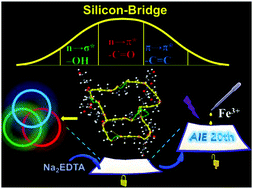Multiring-induced multicolour emission: hyperbranched polysiloxane with silicon bridge for data encryption†
Abstract
Multicolour emissive nonconventional macromolecular luminogens with aggregation-induced emission have drawn great attention due to their potential application in a wide range of areas. However, the exploration of efficient synthetic strategies and emission mechanisms still remains a challenge. Herein, we report a facile route to the synthesis of hyperbranched polysiloxane (P1) with adjacent –C![[double bond, length as m-dash]](https://www.rsc.org/images/entities/char_e001.gif) O and –C
O and –C![[double bond, length as m-dash]](https://www.rsc.org/images/entities/char_e001.gif) C groups. Surprisingly, it not only showed blue emission under white light excitation, but also exhibited multicolour luminescence under different excitation wavelengths. Especially, multiple through-space conjugation rings can be found between the first generation P1 molecules via DFT calculation; based on its remarkable luminescence properties, we proposed a new luminescence mechanism namely “multiring-induced multicolour emission” (MIE). In addition, the stimuli-responsive behaviour of P1 as well as its application in data encryption based on the quenching effect of Fe3+ was studied. This work provides guidance to design and synthesise nonconventional macromolecular AIEgens with multicolour luminescence.
C groups. Surprisingly, it not only showed blue emission under white light excitation, but also exhibited multicolour luminescence under different excitation wavelengths. Especially, multiple through-space conjugation rings can be found between the first generation P1 molecules via DFT calculation; based on its remarkable luminescence properties, we proposed a new luminescence mechanism namely “multiring-induced multicolour emission” (MIE). In addition, the stimuli-responsive behaviour of P1 as well as its application in data encryption based on the quenching effect of Fe3+ was studied. This work provides guidance to design and synthesise nonconventional macromolecular AIEgens with multicolour luminescence.

- This article is part of the themed collection: Recent Progress on Aggregation-Induced Emission


 Please wait while we load your content...
Please wait while we load your content...